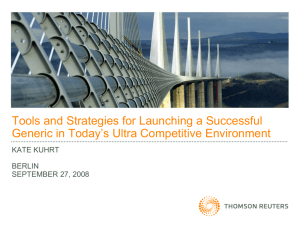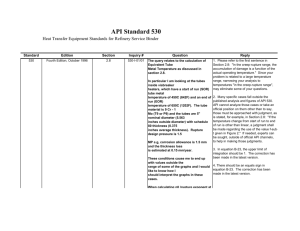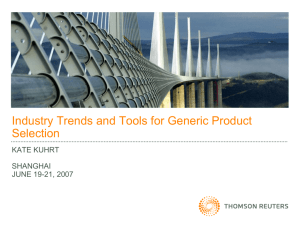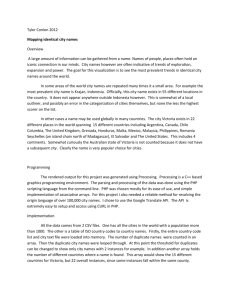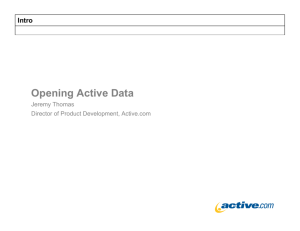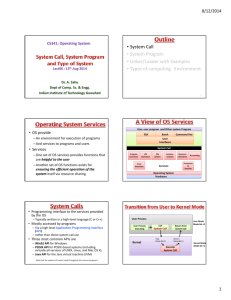THOMSON REUTERS PRESENTATION TEMPLATE
advertisement
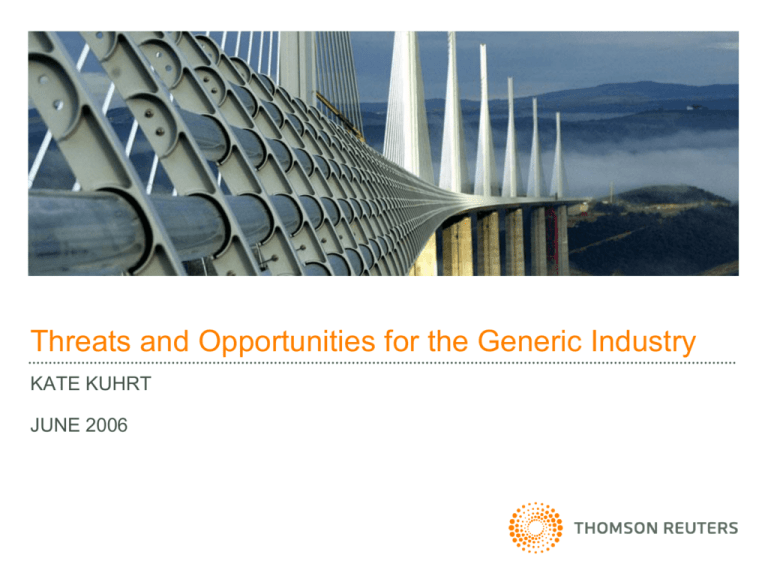
Threats and Opportunities for the Generic Industry KATE KUHRT JUNE 2006 AT FIRST GLANCE, MANY OPPORTUNITIES • Increasing demand for low-cost therapies Proportion of Population Aged 60 or Over – Aging population • US Medicare Drug reimbursement • Reference pricing in Europe 20 10 0 World More Dev – Government involvement 30 Less Dev – Increased generic substitution Percent of Population over 60 – Consumers becoming more cost sensitive 40 1950 1975 2000 2025 Source: United Nations, DESA, Population Division 2050 GENERIC OPPORTUNITIES IN THE U.S. • Products with $100B in branded drug sales are coming off patent in the next 7 years • Patent challenges by generic companies 25 20.1 18.4 30 15.2 15 12.4 10 12.3 10.5 10.0 Top 5 Sales 10 5 0 2006 20 2007 2008 2009 2010 2011 2012 Source: Newport Strategies’ Horizon Global system 0 Number of drugs coming off patent (Newport Constraint Date) Sales Billions USD 20 40 A CLOSER LOOK… • Rapid price erosion in the U.S. and UK • Diminishing margins on both dose and API sales • New regulations in Germany (AVWG) • Settlements between generics and brand companies are delaying generic entry in the U.S. • ANDA approval backlog in the U.S. • Fewer new launches by innovators over the past years will translate into fewer opportunities for generics down the road 5-10% of $100 billion over 7 years, divided among many players and products, does not necessarily translate into a lot of money for every generic company DOWNWARD PRESSURE ON DOSE PRICES • Demand – Purchasers focus on price U.S. ANDA Approvals – Past relationships matter less 400 361 • Supply – Generic filings and approvals at alltime high – A number of new entrants, many from India, often with access to low- cost APIs – Overcapacity in manufacturing – Focus on market share rather than bottom line – Authorized generics in the U.S. Office of Generic Drugs (OGD) approvals – Reverse auctions 300 Indian approvals 296 232 241 2000 2001 320 284 200 100 0 2002 2003 2004 Source: Newport Strategies’ Horizon Global system 2005 DOWNWARD PRESSURE ON API PRICES • Demand – Dose manufacturers focus on price Number of U.S. DMFs – Past relationships matter less • Supply – Overcapacity in manufacturing – Record number of DMF filings – Availability of low-cost APIs from India and China • (Too?) many plants FDA approved 992 1,000 900 772 800 Number of DMFs – Willingness to take the risk and go with less-known API sources Indian DMF's 600 580 639 400 200 0 2001 2002 2003 2004 2005 • Many companies hold COS Source: Newport Strategies’ Horizon Global system COPING STRATEGIES • Consolidation • Geographic diversification • Backward integration into API • Sourcing from India, China, and other low-cost countries • Alliances with companies in low-cost countries • Moving manufacturing to low-cost countries • Focus on niche products COPING STRATEGIES: CONSOLIDATION COPING STRATEGIES: CONSOLIDATION • Likely to see a period of consolidation in pursuit of – Top-line growth – Opportunities in new markets – Synergies • Result: Industry will likely be dominated by a handful of global players plus many small players • Barr’s rumored $2.1B acquisition of Pliva – Biogenerics • 2005 deal to develop a generic version of Amgen Inc.'s Neupogen – New dose forms – Presence in emerging markets – API COPING STRATEGIES: GEOGRAPHIC DIVERSIFICATION • Opportunities in Europe – Counterweight to the U.S. generics market • DRL-Betapharm, Matrix-Docpharma, Ranbaxy-Terapia – Competition among Indian companies driving up prices of companies – Commoditization of German generic market? • Japan – Merck KgaA in Japan since 1998 – In November 2005, Ranbaxy increased equity stake in JV with Nippon from 10% to 50% – In March 2006, Teva applied for approval to sell drugs in the Japanese market – Dr. Reddy's considering setting up an office in Tokyo or Osaka by the end of next March COPING STRATEGIES: BACKWARD INTEGRATION INTO API • Recent example: Watson - Sekhsaria • Pros – More control over cost and access to API • Decreasing number of established API manufacturers still independent – Different parts of the value chain may make money in different products • Cons – No one plant can make all APIs required by a typical generic – Making just enough for captive use often not economical – Other dose companies wary of buying API from a competitor COPING STRATEGIES: MOVING MANUFACTURING AND R&D TO LOWERCOST COUNTRIES • Applies to both API and dose manufacturing • Recent example: Watson – Acquired from DRL a small solid oral dose plant in Goa – Increased investment in an FDA-approved Chinese/Taiwanese API manufacturer • Sandoz – multiple units in India • Teva – scientists in Faridabad, acquired Regent Drugs (JK) • Apotex – manufacturing and R&D facilities in Bangalore • Ratiopharm – R&D center in Goa • Stada – “Complementation of existing Group-owned production sites in GER, NL, and IRL by production sites in “Low Cost Countries” Russia, Vietnam (50:50 JV) and China (currently only local orientation)” (Stada Corporate Presentation 2006) COPING STRATEGIES: ALLIANCES WITH INDIAN COMPANIES • Zydus Cadila – Distribution agreement with Mallinckrodt – 50/50 JV with Mayne for cytotoxic dose and APIs • Glenmark – Development and supply agreement with KV for 8 ANDAs – Agreement with Invagen for 7 products – Deal with Konec for nitroglycerin and with Interpharm for naproxen • Lupin – Injectable ceph generics with Baxter – Oral ceph generics with Watson COPING STRATEGIES: SOURCING FROM INDIA & CHINA • Many highly qualified API sources in India and China • India – 68 FDA-inspected API manufacturing sites – 33 FDA inspections in FY2005 (20 API, 7 Dose, 3 API/Dose, 3 Labs) • 22 NAI (no action), 11 VAI (voluntary action), 0 OAI (official action) • China – 69 FDA-inspected API manufacturing sites – 15 FDA inspections in FY2005 (14 API, 1 repacker) • 6 NAI, 9 VAI, 0 OAI • Are FDA inspections in India and China less stringent? COPING STRATEGIES: SOURCING FROM INDIA & CHINA • Generic companies’ willingness to use second- or third-tier API manufacturers is particularly damaging157 to Italian182 API manufacturers 195 1,059 # of API manufacturers 100% 80 ROW 60 40 Italy 20 China India 0 Established Less Established Potential Future Local Source: Newport Strategies Horizon Global ™ COPING STRATEGIES: FOCUS ON NICHE PRODUCTS • Products with small sales no longer count as “niche” – Even $20M products attracting a lot of interest • Margins in difficult formulations likely to remain higher – Inhaled products, certain injectables • Biogenerics – Teva, Sandoz, Pliva FUTURE • Will focus on price backfire? • Is the number of suppliers going to decrease enough to give the remaining players more negotiating power? • What will be the impact of generic entries from China? THANK YOU! Kate Kuhrt Director, Generics and API Intelligence Thomson Reuters 215 Commercial Street Portland, Maine 04101 USA + 1 (207) 871-9700 x26 kate.kuhrt@thomsonreuters.com
